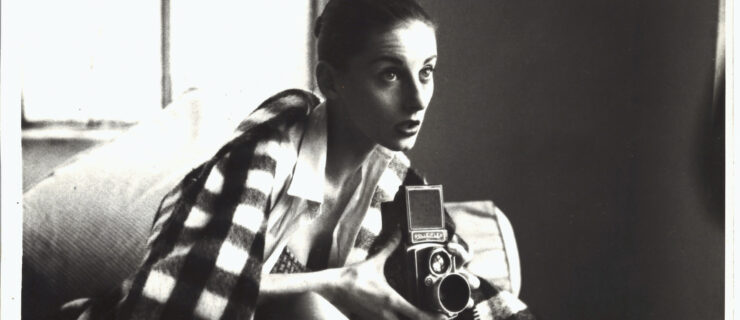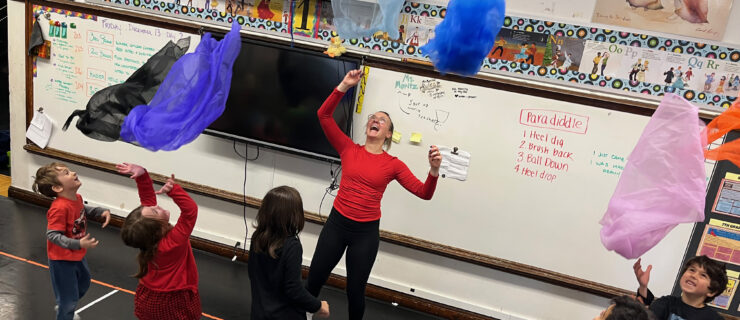On the Rise: Andrea Parson
The bucketful of water that doused Andrea Parson was the first shock of the night at last fall’s premiere of Not I. Sarah Slipper, the artistic director of Portland, Oregon’s Northwest Dance Project, created the work on Parson, who began the piece alone on a bare stage under a spotlight as the water poured down.
The second jolt came from the piece’s physically and emotionally wrenching choreography, set to Not I, Samuel Beckett’s spoken-word monologue of madness. Parson, a lithe, compact dancer, was riveting as a woman wrestling for her own sanity. In her drenched cotton shift she was agitated, vulnerable, determined, and agonized. “Parson maintains exquisite control as she twists and corkscrews slowly through the disturbances of the old woman’s mind,” raved Oregonian critic Bob Hicks. “It’s a remarkably physical characterization of dissolution—perhaps dementia, perhaps death itself.”
“I knew that just to dance wouldn’t work,” Parson says. “I had to rise to that voice. It was loud and outrageous. I wanted to do justice to it. Afterward I was more exhausted than I’ve ever been, just from the emotion.”
Nearly every colleague describes Parson, 23, as a tireless worker. But in the last two years, her artistry has developed. The 10-member contemporary company offers its dancers the all-too-rare opportunity to have new work set on them by emerging and established choreographers. Parson has taken full advantage of learning different movement styles, becoming a versatile and fearless performer in the process.
“She’s not afraid to take movement and develop it in front of you, which makes her very easy to work with,” Slipper says. “She’s not afraid to go into new territory. Her presence has started to come out recently. She’s not a student anymore.”
When she was 3, Parson began classes in ballet, jazz, tap, and modern at the Northwest Conservatory of Dance in Hillsboro, Oregon. When she was around 12, she says, she began to take dance seriously. “Every year I begged for more dance classes,” she remembers. “It gets expensive.” At 17, the small-town girl went to study at the Joffrey Ballet School in New York City—a bit of culture shock she took in stride. “I was fascinated and inspired by all the dancers I saw in New York,” she says. “It pushed me to get up to that level.”
Though her parents encouraged her studies, her father balked when she chose to major in dance at Los Angeles’ Loyola Marymount. “He was like, ‘What are you planning to do with a dance major?’ That was kind of hard—you begin to doubt yourself, too,” she says. But after a tough first year, she felt determined to make a career as a dancer. She studied at the San Francisco Conservatory of Dance one summer and twice with NWDP. The latter proved pivotal.
“I had never seen dance like that before,” she says. “I could tell the dancers were ballet-trained, but I hadn’t seen a lot of contemporary ballet. I was struck by the lines, the physicality, the speed.” She graduated from Loyola in 2008, and NWDP asked her to join the company that year.
Since then her education has been bolstered by working with dancemakers while they puzzle out steps. “There’s no better way to find your artistic voice than to work with choreographers who are finding their artistic voice,” she says. “When they’re creating on me, they’re being pushed and I’m being pushed. That’s huge.”
It shows. In Two Studies for Four Singles, by Hubbard Street Dance Chicago resident choreographer Alejandro Cerrudo (“On the Rise,” Oct. 2007), Parson and partner Viktor Usov turned in a sultry soft shoe. Says Cerrudo, “She has a calm and powerful quality in her dancing.” Another standout role for Parson was the vampish, slightly unhinged female lead in Aszure Barton’s eccentric duet Be Little. “I loved her willingness to be uncomfortable, to just go for it,” Barton says. “She’s really smart; she has maturity for such a young dancer.”
As Parson enters a new year, she is performing and touring with the company, teaching in its new studio, and thinking ahead to the future. “I really like where I’m at, but I’d also like to travel and work with other choreographers and artists,” she says. She dreams, too, of making her own work and maybe, some day, having her own company. “That’s the fantasy,” she says, “but you have to dream big.”
Heather Wisner is an editor at
Make-Up Artist magazine and a Portland, OR, dance writer.
Pictured: Parson in the studio. Photo by Blaine Truitt Covert, courtesy Northwest Dance Project




